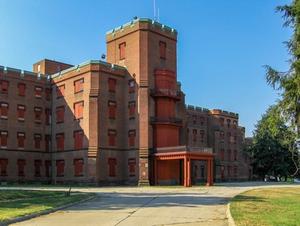DHSDHS HQ: Doubts grow about trouble-plagued St. Elizabeths complex
DHS was supposed to move into its new, centralized headquarters on the grounds of the historic St. Elizabeths, in 2015, at a cost estimated to be about $3 billion. Today the project is $1.5 billion over budget, eleven years behind schedule, with thousands of DHS employees working at more than fifty scattered, expensively leased office buildings. Some lawmakers doubt whether the complex will ever be completed. A congressional aide familiar with sentiments on the Hill says: “It’s [the original St. Elizabeths complex plan] just not going to happen. The money doesn’t exist.”

The St. Elizabeth campus, hoped-for DHS headquarters // Source: wikipedia.org
In the aftermath of the 9/11 attacks, the George W. Bush administration proposed a new centralized headquarters to house the Department of Homeland Security (DHS). The historic St. Elizabeths complex, former home to the first federal psychiatric institution, located in Southeast Washington, D.C., a few miles from the Capitol, was selected. Under the plan, more than fifty historic buildings would be renovated in addition to new developments to house roughly 14,000 DHS employees.
Today the project is $1.5 billion over budget, eleven years behind schedule, thousands of DHS employees are working at scattered leased office buildings, and some federal officials doubt whether the complex will ever be completed.
According to the Washington Post, the complex was to be completed by 2015 at a cost of less than $3 billion. Instead, only a building for the Coast Guard has been developed. Recent budget update estimates the final cost to reach $4.5 billion, with a completion date pushed to 2026.
The St. Elizabeths complex was promoted as the largest construction project in the Washington, D.C. area since the Pentagon was completed in 1943. Current and former federal officials now consider the status of the project as a representation of Washington’s inefficiency. A shortfall in funding has delayed construction, which drove up costs overtime. DHS agencies are now located in more than fifty locations throughout the Washington area and have been signing expensive temporary leases.
“The cost of the project has increased due to the extended timeline,” said Mafara Hobson, a spokeswoman for the General Services Administration (GSA), which is developing the project for the DHS. “GSA and DHS haven’t received the appropriations that this project needs to keep it on its original schedule. Construction is a commodity market, and costs increase with delays.”
Government planners were aware that renovating St. Elizabeth would come at a premium price. Rehabilitation of antiquated utilities and infrastructure was necessary partly due to the complex’s status as a national historic landmark. It was only after approval of the first master plan in 2009 that officials discovered that transportation improvements on nearby roads would cost over $100 million. Increasing construction costs and a slow rate of funding from Congress have led some lawmakers to propose foregoing the project. “Sometimes you just have to drop back and punt,” said Representative Jeff Duncan (R-South Carolina), whose oversight subcommittee has criticized federal management of the project. “At what point in time does the government just cut its losses and look for a better way of doing things?”
Former DHS secretary Michael Chertoff, who once stated that a main headquarters was essential for the department, now acknowledges that the project has been managed poorly. “I suspect there is no constituency for building a new headquarters complex right now,” he said. Chertoff notes that a consolidated headquarters would have made logistics more efficient during the government’s response to Hurricane Katrina in 2005 and to a 2006 terrorist plot to blow up transatlantic airliners with liquid explosives. “People were shuttling back and forth in those critical days after the plot was exposed, and that just made it much more difficult and time-consuming,” Chertoff said.
The St. Elizabeth complex was selected because it was the only location that met size and security requirements. Community leaders supported the plan because they believed it would boost the Anacostia and Congress Heights neighborhoods, but now lawmakers are calling for a reevaluation of the project, and some are suggesting that private developers could build a smaller office complex on the site and lease it to DHS. “It’s [the original plan] just not going to happen,” said a Republican congressional aide. “The money doesn’t exist.”
A revised White House plan to build the complex by 2026, submitted to Congress last year, requested an average of $280 million a year, the Obama administration received just $190 million this year.
